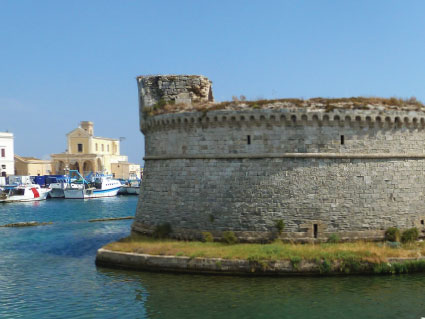




"With the sound of the big bell of the church of San Francesco d'Assisi still ringing in the air, those same chimes that on the stroke of midnight of Shrove Tuesday mark the end of carnival, at the crossroads of the streets in the old town of Gallipoli, the Caremma, made her appearance." The Caremma is the effigy of a woman dressed in mourning clothes, symbolising abstinence and the mortification of the flesh. For a some years now the ancient practise of hanging these rag dolls at the crossroads in the town on Ash Wednesday has been taken up again, not only in the old town centre, but throughout the whole town. In traditional folklore, the Caremma is a figure of good fortune and a warder off of evil, it is shown holding a spindle and bobbin to symbolise industriousness and the passing of time. Tied to its feet there is usually a "marangia" (a bitter orange), its flavour represents sufferance, affliction, and repentance. The skin of the orange is pierced with seven capon feathers, representing the seven weeks of Lent preceding Easter. With every week of Lent that passes, one of these feathers is removed, until the day of the resurrection, when after the last feather is removed, at the stroke of 12.00 (midday) on Easter day, the Caremma is burned, symbolising the end of Lent, a rite of salvation and purification. We identify this figure with our sadness and worries, with the troubles that need to be extirpated by fire in order for us to be able to fully appreciate Easter. Many people think that the Caremma represents the mother of Titoru (one of the characters of the Gallipoli Carnival who died by choking on a meat ball due to his gluttony on Shrove Tuesday), others think that she represents Clotho, one of the the Greek Fates (Moirai), who holds the destiny of man in her hands, because the rag dolls are made holding a spindle and bobbin, still other people believe it is the representation of a woman mourning the death of Jesus Christ while waiting for the Resurrection, that is in fact Easter. The real origins of the Caremma are lost in the mists of time. The term Caremma has French origins, probably from French soldiers who associated the rag dolls in mourning clothes with "Careme", a French term that translates as Lent. Places where you can see the Caremma and their bursting on Easter Sunday:
- In the Old Town: Corte Gallo, Via Ribera and on the Bastione del Giraro in riviera N. Sauro; - In the town: in Via Castriota on the corner with Via G.G. Russo; - In the PEEP area: Via Berlinguer, and in the nearby park a small children's party is held, where Pupe and Caddruzzit, typical Easter sweetmeats, are handed out to the children.